Current Affairs
The panel—ANU professors Kent Anderson, Peter Drysdale, Jenny Corbett, Tessa Morris-Suzuki, and senior lecturer Shun Ikeda —presented their views last November at a joint public forum organised by the newly formed ANU Japan Institute and the Australian Institute of International Affairs (ACT Branch).
Opening discussion, Professor Anderson said that in the aftermath of the election that ended nearly 55 years of Anderson said the only thing that had united the Democratic Party was the view that the LDP should not be in power, and keeping the party’s coalitions together would have to be watched. After spending a month in Japan late last year, Anderson admitted that he was wrong in his caution. ‘I think this change is real. I think I’m seeing something I‘ve not seen in all my experience of following Japan,’ he said. ‘The politicians are taking a lead and there is a shifting of policy away from the traditional areas to consumer welfare—a shift to urban areas at the expense of rural industry interests. We’re also seeing real change in independence from the United States.’ Although Anderson did not see a shifting of the importance of the coalition between the United States and Japan and Australia, he saw a challenging of issues such as the friction with the United States and Japan over the US helicopter base on Okinawa.
Agreeing with Anderson that a significant political change appeared to be happening, Professor Corbett—also recently back from Japan—said she had gone there as a skeptic and returned—not optimistic because on the economic front optimism was not the right word—more curious and less expecting business as usual. During the election campaign the DPJ was selling itself to the voters as being concerned about consumers, the elderly, young people who were unemployed, and small and medium enterprises. ‘It was definitely a manifesto which said resources and attention should be shifted where possible to those groups and away from the big powerful, traditional supporters of politics in Japan—the big business interests,’ she said. ‘However, the DPJ was very vague and, disappointingly did not say anything in its manifesto about how it was to achieve this. None of these resource transfers can be easily achieved at the best of times, but they’re going to be infinitely more difficult if you have a slow-growing economy, and that is Japan’s big problem.’ Since coming to power the DPJ had moved ‘quite quickly’ on some of its electoral promises, such child benefits and job-seekers’ allowance—all handouts to people seen to be struggling in the current Japanese system. But the hard part was determining where that money was going to come from. In public, the government had said the money would come from big cuts in the public sector—by eliminating waste, by a massive productivity dividend from the public sector and by cutting some public works-type programs. Because the DPJ had said it was not going to raise consumption tax—at least not for a few years—it was unclear what it planned to do regarding tax. |
“I think it’s being deliberately vague, certainly until after the Upper House elections. What we may see is the need to issue new government debt to fund this, at least in the first few years, and they’re certainly panicking the markets that they may be going to do this,’ she said. ‘The real problems for the Japanese economy are long term in that they’re the facts of an ageing population and a strengthening currency. Most of Japan’s economic growth over the past six years has come from exports, so any government in Japan needs to be looking at the long-term productive capacity of the economy—how do you get productivity back into this economy?’
On foreign policy, Professor Tessa Morris-Suzuki said Japan’s new government had come to power in the middle of an important turning point for the East Asian Region as a whole, when there were all sorts of questions over the future role of the United States in the region, over the role of China and over Japan’s relations with its neighbours. Prime Minister Hatoyama was eager to develop a policy that balanced the US–Japan alliance and close relations with Japan and its Asian neighbours, but how that was going to work out remained to be seen. ‘For the past couple of decades or so, since the ending of the Cold War in Europe, the Japanese Government under the LDP had been struggling to find a new place for Japan in a changing regional order,’ Morris-Suzuki said. ‘Obviously the big issue is the rise of China, the fact that Japan is no longer unequivocally the economic powerhouse. What is Japan’s economic and political role in this changing region?’ On the whole, Morris-Suzuki said, successive LDP governments had failed to find a new role for Japan in the region. Despite various efforts, the LDP really did not manage to face up to Japan’s historical responsibility in a way that satisfied regional neighbours. To a degree, this had to do with the fact that Japan had been in a subordinate position to the United States, which had enabled it to get away with not facing up to the historical past. ‘From that point of view, the advent of the new government in Japan does bode well for the future. Hatoyama is known for his quite liberal foreign policy stance, particularly for being a keen advocate of an East Asian community. His vision of the community has been criticised for being rather thin on specifics, but he is clearly very committed to good regional relations; he is not burdened with a history of making tactless statements about the war,’ she said. In terms of relations with Australia, Morris-Suzuki believed there were a lot of positives. It was important to Australia that close, cooperative relations developed between the countries of North-East Asia, which were overwhelmingly our major economic partners.
Shun Ikeda referred to a debate in over the retention of so-called mind notes, known as Kokoro or Nooto—a kind of supplementary text book for ethics education—and the impact that the outcome could have on future Australia–Japan relations. The notes have been in existence since 2002 and were a government-imposed moral and ethics view on primary and secondary school children. |
‘Even before the DPJ was elected it had been saying that the mind notes should be abolished,’ Ikeda said. ‘At the moment almost all Japanese schools have been adopting the mind notes to complement the moral education textbooks. These textbooks in Japan are inspected, but not censored, by the Ministry of Education and Science. However this particular supplementary text has not been inspected by the Ministry nor discussed in public, so the DPJ regards this as an imposition of the government’s stance on to Japanese students at the primary and secondary stage.’ The new government, said Ikeda, was trying to abolish this supplementary text, which the previous government had distributed to all schools at primary and secondary levels. ‘Naturally it had opposed the introduction, saying it would lead to the nationalisation of moral education. So there is a big debate at the moment, which perhaps is not attracting media attention yet, but may influence some of the things that Australia will find when dealing with Japanese in the future,’ he said. ‘Whenever you deal with Japanese, you can to some extent anticipate where they come from and what their basic moral and ethic standard is. But if this kind of unified morals supplementary text is abolished, then each and every school can choose its own supplementary text. Perhaps Australians who deal with the next generation of young Japanese may find they’re not as predictable as they are at the moment.’
Noting a new assertion of policy authority by the political leadership since the election of the DPJ government, Peter Drysdale said this would affect the way Australia did business with Japan in future. ‘We’ve had a situation in Japan where senior bureaucrats basically declared government policy without reference to the political process almost at all, but this has changed fundamentally,’ he said. ‘There is a new assertion of policy authority by the political leadership, which will change the way we have to do business with Japan. It means in respect of all Japan’s relations—not only the Australian relationship—but also importantly the US relationship, that there will be less predictability. Japan will be less of the one-stop policy shop it was in the past.’ These changes, said Drysdale, would require a much more diplomatic energy and effort to understand what was going on in Japan and to connect effectively with it in the management of our interests in Japan. This was potentially a fundamental change in the relationship between Australia and Japan. ‘I’m not sure whether Australia is up to this, whether we have the resources in government, in the universities or in the community more broadly to put the effort into engaging with Japan in a way that will realise the potential. There’s huge potential in the development of the new relationship with Japan through the election of this new government, but it does require a lot more effort and engagement on a wider front than we’ve been used to in our dealings with Japan in the past.’ |
A full transcript of the discussion can be found on ANU Japan Institute website. |
||
Education
 |
AEF ENCOURAGES FEEDBACK ON NATIONAL CURRICULUMThe Asia Education Foundation (AEF) is encouraging teachers and academics to provide feedback on the draft K-10 Australian Curriculum, which was released on 1 March. |
The release of the draft by the Australian Curriculum, Assessment and Reporting Authority is the next stage in a process that commenced in August 2008 to develop national curriculum covering English, mathematics, science and history. The AEF developed responses to the proposed framing papers for English and History, calling for greater Asia literacy in both disciplines. ‘Our response focuses on the importance of the Australian context for learning—the ‘Australian story’, as developed by Professor Tony Milner, Basham Professor of History, ANU and Professorial Fellow, Asialink,’ said AEF Director Maureen Welch. ‘The ‘Australian story’ recognises’ that the Australian context for learning is unique. It necessarily includes Australia’s relationship with Asia, and that this relationship defines our individual, collective and national identities. ‘Importantly, it recognises that that the ‘Australian story’ is not “added” content, but fundamental to Australian students’ understanding of their world, and should be embedded into the curriculum, kindergarten to Year 12,’ she said. |
The AEF argues that engagement with traditional and contemporary texts that examine a range of worldviews, issues of culture, identity and difference is at the heart of English. ‘A contemporary Australian English curriculum therefore must incorporate texts from and about Asia if it is to broaden students’ worldviews and acknowledge the traditions, ideas, craft and inspiration that the Asian region, our neighbourhood and home to more than one-third of the world’s population, offers,’ the AEF believes. ‘In addition to providing our students with access to the rich canon of texts that reflect the human experience of our neighbours, ‘Asia literacy’ in English also counteracts any vestiges of orientalism and colonialism that may prevail in students’ lived experience inside or outside the classroom.’ The AEF is concerned that the current approach to content decision-making in schools often denies Australian students their entitlement to develop an awareness of the literary traditions and expressions of other nations in the Asia-Pacific region. |
This entitlement will only be realised, the AEF argues, if it is backed by mechanisms that ensure content supporting ‘Asia literacy’ is delivered by explicit teaching of Asia-related texts and content. Similarly, the AEF argues that references to Asian people, cultures, societies, events, sources and artefacts should be a core part of the study of History. It is not enough, says the AEF, to provide an option for teachers and students to choose to study Asia: the data indicate that where this occurs, only a minority take-up the option —both students and their teachers. ACARA’s work in developing the Australian curriculum is guided by the 2008 Melbourne Declaration on Educational Goals for Young Australians. |
Displacement
Displacement, division and renewal figure prominently in perhaps the greatest crisis facing human civilisation—the growing metabolic rift (Foster, 2009) between humans and the non–human world. Call it environmental degradation, global warming, climate change, declining biodiversity, uncontrollable capitalism or unsustainable development—the signs are that our life-support systems are being displaced, divided, fragmented and destroyed by models of economic and industrial development rooted in 18th, 19th and 20th century social and economic transformations. Responses to the growing crisis have been varied, each with different implications for human relations with the There are those who seek to promote a more planned or strategic capitalism, also known as ecological modernisation or growth–within–limits, in which continued economic growth can be married to environmental conservation through cooperation among technocratic, business and government elites. A third grouping consists of eco–socialists, eco–centrists, radical environmentalists and others calling for a radical transformation of contemporary industrial capitalism through a dismantling of industrial and/or capitalist forms of production, exchange and consumption and their replacement by decentralised and more communitarian models of environmental governance to support economies of need rather than accumulation. Over 40,000 representatives of these and other groupings came together at the COP–15 meeting in Copenhagen in 2009, officially organised to provide a legally binding successor to the 1997 Kyoto Protocol. In this it failed. In its place was the Copenhagen Accord, a non–binding agreement in which developed countries committed to reduce emissions and provide more funding for adaptation, but not enough to limit temperature rises to 2 degrees centigrade above pre–industrial levels or to meet the costs of adaptation (Parry, 2010). |
Geopolitically, the conference saw the emergence of a group of wealthier developing countries, two from the Asia–Pacific region, referred to as BASIC (after Brazil, South Africa, India and China). BASIC played a major role in brokering the Accord and sees itself as speaking for other developing countries (a role challenged by some) and potentially a rival to the G77plus China. Watching this spectacle from the geographic, social, economic and political margins were the billions of people in developing countries who are most affected by climate change and attendant social, political, economic and environmental changes.
Current market and state-directed economic growth policies, which in India and China continue to be driven by high modernist ideologies based on domination of nature, faith in science and technology, and a politics of authoritarianism or managed democracy (Scott, 1998), are resulting in uneven development between town and country, growing wealth and income differences between rich and poor, massive reliance on fossil fuels as energy sources, and ecological disruption on a large scale. Small island states such as Tuvalu and Kiribati face the possibility of human displacement as populations grow, land and sea become less able to feed the populations and sea level rise threatens their very physical existence. |
The impacts of development policies, export–led industrialisation strategies combined with the absence of climate change policies or their poor integration into development planning are best observed at the local and regional levels. It is here that forests disappear, coastal land becomes increasingly saline, rice yields decline, fish stocks disappear or shift their location, urban renewal and post–disaster programs displace thousands, and corporate, donor–financed and state–driven resource extraction continues unabated. These policies and strategies, which have often led to displacement and division are increasingly questioned, renegotiated, and resisted by a politics of renewal led by local people, NGOs, journalists, action researchers and others. This politics of renewal can be seen when Indian adivasi groups oppose bauxite and other mining on their lands or ‘translate’ development policies into their own terms (Mosse, 2005); when Torres Straits Islanders resist relocation by building homes on stilts or higher ground (Green, 2009); when artisanal fishers and small–scale farmers support community and adaptive eco–system based management of local resources; when peoples from Latin America to Indonesia create maps against power and re–configure space and place in local terms (Rocheleau, 2005); when ‘nations’ such as the Palestinians struggle for retention of their homelands; and when the ecological debt movement seeks redress for centuries of appropriation of local resources and the enclosure of the global terrestrial and atmospheric commons through reparations, wealth redistribution and a politics of environmental justice. As academics, public intellectuals, researchers, teachers, advocates and policy advisors, we have an intellectual, ethical and civic obligation to challenge the politics of displacement and division and replace it with a politics of hope and renewal. This lies at the heart of the RUSSIC/Curtin Sarawak Displacement, Division and Renewal: Borneo Conference 2010 that will be held at Miri, Sarawak, in July. |
Bob Pokrant is Professor of Anthropology in the Social Science program in the Faculty of Media, Society and Culture at Curtin University of Technology and Director of the South Asia Research Unit, which carries out research and provides postgraduate training for students interested in India, Bangladesh, Pakistan, Sri Lanka, the Maldives, Nepal and Bhutan. Conference registration forms can be downloaded, along with information on conference accommodation and conference paper abstracts. References John Dryzek (2005, 2nd ed): The politics of the earth: Environmental discourses. Oxford: Oxford University Press |
||
Profile
|
NEW DIRECTOR FOR MURDOCH’S ARCThe new Director of Murdoch University’s Asia Research Centre, Associate Professor Caroline Hughes, says her appointment comes in the middle of a period of immense success and rapid expansion for the centre. |
Tell us about your academic background and research interests leading up to the appointment? I’m a recent immigrant in Australia, having spent most of my academic career in the United Kingdom. But since my research has always been focused on Southeast Asia, it’s a great opportunity for me to be working here in Australia, where interest in the region is so strong. I did my postgraduate training at the now sadly defunct Centre for Southeast Asian Studies at the University of Hull in the north of England, and subsequently worked in Politics departments at the University of Nottingham and Birmingham. I’ve combined my area of interest in Southeast Asia with a thematic interest in the politics of countries emerging from war. I’m particularly interested in how local populations understand and respond to international aid and peace-building interventions, and in using political economy to explain these responses. The latter interest led inexorably to my decision to move to Perth to work with the Murdoch Asia Research Centre. As Director, what will be your priorities? I’m very privileged to be coming into this post right now, since the Asia Research Centre is in the middle of a period of immense success and rapid expansion. Last year we were successful in gaining two ARC fellowships: an Australian Professorial Fellowship for my predecessor, Professor Garry Rodan, and a Future Fellowship for Professor Vedi Hadiz from the National University of Singapore. The presence of these two prolific and internationally respected figures as full-time researchers in the centre will allow us to expand our research programs and activities quite significantly. The centre is focused on pure research, and consequently our priority is to continue to target these kinds of prestigious prizes, as a means to increase our capacity even further, and to bring exciting scholars from around the world to Murdoch and Australia. What are the centre’s strengths? Our people, our distinctive approach and our substantive agenda. The main reason for our strength is that we have some of the highest calibre of scholars working here. But we are also effective because we have a clear and focused research agenda. Our work is based around a common interest in using political economy approaches to understanding conflict in Asia, and this approach provides a unified theme for our programs, while distinguishing us from other Asian Studies institutions in Australia. Different scholars within the centre are taking this core approach in different and exciting directions, and several members of the Centre have also begun looking at cross-regional comparisons. I think that is important in keeping our contribution lively and innovative.
|
The substantive areas in which we are working include security, governance reform, and environmental issues, under the umbrella of our flagship New Modes of Governance in Asia programme. These are all areas in which there is intense interest and therefore we are able to position ourselves at the centre of hot theoretical and policy debates. Your own work has a strong focus on aid and post-conflict reconstruction development, especially in Cambodia and Timor-Leste. Will this be reflected in the centre’s work? Focus on international aid politics in least-developed countries has always been of interest to colleagues in the centre. In 2008, a team led by Professor Richard Robison, and including Dr Jane Hutchison, Dr Ian Wilson and myself, were successful in gaining funding from AusAID’s Australian Development Research Awards to look at the politics surrounding international efforts at promoting governance reform in the Philippines, Cambodia and Indonesia. This is an area in which we will continue to work. We also recruited one of our former PhD students, Dr Shahar Hameiri, as a permanent staff member last year. He is already a widely published expert on state building. So the centre is already moving in this direction to some extent, and I hope that in my capacity as director, I will be able to both support and contribute to this aspect of our work. What started your interest in Cambodia and Timor Leste in particular? My interest in the region developed when I was working as a newspaper reporter in Hong Kong in the early 1990s. At that time, I wrote some news reports about the plight of Vietnamese asylum seekers and refugees in Hong Kong camps, and I became interested in the changes going on in Vietnam, Laos and Cambodia. This led me into almost a decade of work focused on the dynamics of Cambodia’s political transition, and subsequently into comparative work on international aid politics, post-conflict reconstruction and governance reform in the region.
|
After 1999, the comparison with Timor-Leste appeared an obvious direction to move in, and I’m glad that I did. Not only did I fall in love with the country—as many visitors do—but it was also most revealing in terms of challenging some of my assumptions about what had happened in Cambodia. Both countries continue to fascinate me, but since coming to Murdoch I’ve also had the opportunity to collaborate on projects looking at governance reform in Indonesia and Vietnam too. While taking up directorship of the centre, you will also continue as Academic Chair of the Masters in Globalisation and Governance Program. Tell us something about this program and whether it will overlap with the centre’s program? The Masters in Globalisation and Governance is designed to introduce Masters students to the work going on in the centre. The core unit, States, Globalisation and Governance, is focused on case studies from the Asian region, and has contributions from guest lecturers from the centre. We hope to attract students from the region, and also students who might be considering going on to undertake PhDs in the centre. What are your most significant academic achievements? I’m most proud of two things. The first is my recent book published last year by Cornell which compares post-conflict reconstruction in Cambodia and Timor-Leste. While it contains many flaws, I think I succeeded in using the comparison to highlight some of the inherent tensions in the neo-liberal project that are revealed when this is transposed into post-conflict situations. The second is my longstanding collaboration with the Cambodia Development Resource Institute in Phnom Penh. I’ve acted as an external advisor and collaborator for programs at the institute for more than a decade, and the relationships that I’ve built up with researchers there are very important to me. And your current research priorities…? At the moment I’m focusing on an Australian Research Council project with Professor Garry Rodan on the politics of accountability reform in Asia. This has been a very exciting project in that it has allowed me to expand my focus beyond my existing countries of expertise. Right now, I’m in the middle of trying to understand the political complexities behind recent tribulations of the Indonesian Anti-Corruption Commission. It’s a fascinating story and I hope to return to Indonesia soon to pursue it. |
Art and Culture
Change in traditional and communist societies in Southeast Asia is profound. Focusing on contemporary art in a range of media reveals far more than that shown in the tourist promotional images. Richard Streitmatter-Tran, through his teaching and research in the Mekong region, curated a section of APT 6. The artist, Jun Nguyen-Hatsubisha, whose parents are Vietnamese and Japanese was raised and educated in the United States, as was Richard Streitmatter-Tran. Jun Nguyen-Hatsubisha’s video The Ground, the Root and the Air: the Passing of the Bodhi Tree 2004–07 was a wonderful introduction to this section of the exhibition. Jun worked with students from the School of Fine Arts in Luang Prabang, who provided the performative aspect of the artwork within an artwork.
The students are seen first at dawn, marching in the street as the Buddhist monks process along the road to collect food donations. The next town scene is an old 1960s cement stadium in which the students drill in new contemporary exercise gear. The stadium has echoes of some of the most barbarous scenes of the 20th century, such as the massacre of leftists in Santiago, Chile, and other massacres closer to home. The scenes shot on the Mekong are spectacular because of the rugged mountainous terrain and the hazy early morning mist. Individual students stand in the prow of the shaped river boats, so common to Southeast Asia, drawing or painting the landscape in black and white. The sound of the ‘putt putt’ engines is simultaneously cut in one scene which emphasises the role of sound throughout this video. The loose narrative of the title is existential and performative, so that when the students pass a large bodhi tree that has been walled as an island against erosion, some dive into the muddy water and swim as if spontaneously and mysteriously drawn to this ancient shrine. The artist leaves the viewer with haunting images that conjure the beauty of the Mekong and the young postwar generations that make up the largest number of people in the region. Svay Ken’s paintings from Cambodia pick up this theme of the young and their instruction. A self-taught artist from a family of farmers and temple-painters, Svay Ken’s paintings in the series, ‘Sharing Knowledge’, illustrate Buddhist moral statements which aim to guide a younger generation who did not experience poverty, famine and genocide. |
The generational conflict is a significant aspect of societies in this region. Svay Ken illustrates with direct figurative images and text, the moral hazards for those who are ashamed of poor and uneducated parents and relatives. One painting refers more directly to famine and genocide under the Khmer Rouge, the grisly, ‘Leaving the meat and chewing the bones leads one to ruin’ 2008. Sopheap Pich, also from Cambodia, is represented by a series of sculptures, the 1979 series, in which he recreates his experience as an eight year old walking with his family back to their home town of Battambang following the fall of the Khmer Rouge regime to the Vietnamese. In a devastated landscape, the detritus of a formerly developing country were scattered everywhere. The impact on a youngster who had known the impoverished and brutal society of the Khmer Rouge Year Zero is apparent in these loose open-weave sculptures of bamboo and rattan. An industrial machine, binoculars and a Buddha are made in open weave, natural materials often accompanied by small wooden buffaloes.
The abstraction and changes in scale in the objects represented make them more beautiful but also more moving. Sopheap Pich also lived and studied in the United States of America, linking him to Richard Streitmatter-Tran and Jun Nguyen-Hatsubisha and showing the leadership from the returning diaspora that is happening throughout Southeast Asia. Bui Cong Khanh’s ceramics include two vases over one-metre high and seven smaller vases which depict contemporary life in Vietnam’s cities on the media of traditional off-white and blue ceramic. Contemporary Story 2 in the series depicts an outline of a man covered in traditional decorative motifs but sitting on a modern porcelain toilet holding a hamburger and coke. On the wall a sign reads ‘Live to Eat.’ Other images on his ceramics include propaganda banners, street signage and the title of a song popular in the karaoke bars, ‘Tonight I celebrate my love’. Khanh’s art is satirical and whimsical; it illuminates contemporary life among the huge postwar Baby Boom generation who are caught between authoritarian attitudes and commands and their own hedonistic and materialistic values. |
Two strong photographic series by Manit Sriwanichpoom (b.1961) and Vandy Rattana (b. 1980), from Thailand and Cambodia, respectively highlight contemporary social issues. Manit Sriwanichpoom’s series Waiting for the King 2006 puts a close focus on those urban middle class Thais whose support for the monarchy resulted from the frequent military interventions in Thai politics and power, as much as traditional allegiance to the monarchy. These grim supporters in black and white, suspended in time and place, convey some of the anxieties of people whose confidence in modern public institutions and governance hangs by a thread.
The ‘Fire of the Year’ 2008 was a series of superb photographs of the fire and the ruins of buildings by Vandy Rattana. The composition and depth of field in the photographs, as well as finely observed details and people, convey a complex story. One of the scandals of the rapid development of Phnom Penh is the shanty towns occupied by rural immigrants, or the urban poor displaced by unbridled development. The ironically named Clear Water was a neighbourhood of stilt shacks built above a waste dump. In Fire of the Year’8 a small boy, shirtless and shoeless, sifts through the ashes while balanced precariously on a charred beam, in this image the fragility of life is made palpable. The most intriguing work in Mapping the Mekong is that by two Yangon artists, Tun Win Aung (b.1975) and Wah Nu (b.1977). Prevented from showing their art in modern art gallery spaces this couple has constructed miniature exhibitions in gallery environments and photographed their work in a series titled, Blurring the Boundaries 2009. The gallery interiors are eerie because they lack people. The emptiness is amplified by the large-scale coloured photographic reproductions of these mini-installations that create a void or simulacrum. The work’s title alludes to the boundaries between reality and illusion, quite a potent metaphor for life in the contemporary Union of Myanmar. |
Dr Van den Bosch is an Adjunct Research Fellow at Monash Asia Institute. Her article 'Professional Artists in Vietnam: Intellectual Property and economic and cultural sustainability' was published in the Journal of Arts Management, Law and Society 2009, vol. 39, issue 3, pp.221–236. |
 |
ASIAN ARTS IN AUSTRALIA COME OF AGESince 1991 the Asian Arts Society of Australia (TAASA) has been providing a forum for enthusiasts and experts to share their interests in, and pursue the study of a wide range of arts from the entire Asian region. TAASA president Judith Rutherford, AM, an international expert of Asian textiles, talks about her work and the society’s plans to broaden its reach. |
Your interest in Asian textiles goes back over 30 years. When and how did it develop? My husband worked for Shell International and was transferred on assignment to work on the oilfields of Brunei—this was my first experience of living in Southeast Asia and my first contact with Asia. There were Asian traders who would come to the house with enormous bundles containing everything from antiques to contemporary items. We lived there for five years and by then I had become very interested in Asian culture and had commenced collecting Chinese textiles. In those early days, was it difficult to obtain information in Australia on Asian textiles? On my return, I found there was no interest in Asian textiles and that if I was going to study in the field I was going to have to pursue it as an independent scholar. I made contact with scholars in the United States who had an interest in this area; also the collections that I needed to study were in the USA, the United Kingdom and Europe. Hong Kong was another favourite destination, I would regularly return to Sydney with antique textiles. Gradually I built up a network of contacts overseas. What have been some of the highlights of your long involvement in the field? Working with Jackie Menzies, Head Curator of Asian Art at the Art Gallery of New South Wales (AGNSW) to curate Celestial Silks: Chinese Religious and Court Textiles in 2004. We had a very short lead time for such a major exhibition but all of the overseas contacts came into play and I was able to borrow some very significant textiles, the major donor being Chris Hall, a collector in Hong Kong. I did wonder what the response would be for the exhibition but the catalogue sold out in the first six weeks and the exhibition was very well received, exceeding the predictions for attendance numbers. Another highlight would be my research and collecting of Vietnamese textiles and rank insignia. My initial interest was in Chinese rank insignia but that led me to the Vietnamese examples, mainly because I became frustrated when the Vietnamese examples were so often incorrectly labelled as Chinese. I managed to put together a small representative collection dating from the 18th through to the19th century. I donated them to the Art Gallery of New South Wales as I thought it was important they remain together as a collection. As far as I know it is the largest collection of Vietnamese rank insignia in a public institution worldwide. |
Since TAASA was formed has there been significant development in interest in the arts of Asia in Australia? Absolutely. Twenty years ago the interest in Asian art was in its infancy. That has changed and you only have to look at the attendance at Asian exhibitions and the diversity of these throughout Australia to see how much things have changed. What are the most popular Asian arts in Australia? That is difficult to quantify and depends on which Asian country you’re talking about. I’d say overall ceramics, jades and paintings are always very popular. Textiles have also come into their own and attract good audiences. Is Asian art having much influence on the arts in Australia? There is a long tradition of such influences, for example Japanese ceramics have had a strong impact on Australian potters since the 1960’s and 70’s. Many Asian-background artists are now living or show regularly in Australia and we often profile them in our quarterly journal, the TAASA Review. Asia Link tours exhibitions to the Asian Region. The interest in contemporary art has grown and wonderful things are happening in that area, for example in Brisbane at the Queensland Art Gallery with its Asia Pacific Triennial of Contemporary Art, which aims to encourage engagement with the diversity of cultures which surround us. Another sign of the times is the newly opened private foundation, the White Rabbit Gallery, which showcases contemporary Chinese art in a specially designed gallery in inner city Sydney. . |
Are particular trends emerging regarding Australian interest in Asian art? The major institutions can now charge admission for exhibitions and people are happy to support that concept. How well are our museums, art galleries and educational institutions promoting and displaying Asian art? I think considering budget limitations most of them do very well. One example that comes to mind is the Tuesday ‘Arts of Asia’ lecture series at the Art Gallery of New South Wales, where attendance for their weekly lectures averages 175. Has TAASA any particular projects in mind for the next few years? TAASA will continue to work where possible with public museums and galleries and other educational institutions, supporting their endeavours. We have, for example, taken responsibility for seminars and symposiums to support significant exhibitions of Asian art at the Art Gallery of New South Wales and the Powerhouse Museum such as a one-day seminar on ’Jewellery and Adornment of Asia’ held last July at the AGNSW, which supplemented the theme of the gallery’s 2009 Tuesday lecture series. We’ve been running a very successful series of seminars on ‘Great Cities of Asia’ in both Sydney and Melbourne, and are considering further seminars on this theme. As an organisation, we’re aiming to broaden our reach throughout Australia and have recently expanded our activities in Brisbane |
LECTURES AND EXHIBITIONS |
The Sound of Gold and Stone, New Purple Forbidden City Orchestra, Friday 14 May, 6pm, Canberra. Liu Shun, conductor. China’s finest ensemble of traditional instrumentalists performs classical Chinese music accompanied by poetry from the great dynasties of Chinese history. Narrators Dr John Yu and Dr Richard Rigby. National Library of Australia lobby, Parkes Place. Presented in association with the ANU China Institute and the National Library. Tickets $39 full/$35 concession, Canberra Ticketing, 02 6275 2700. Further details (). Hymn to beauty: the art of Utamaro, Art Gallery of New South Wales, Sydney, until 2 May 2010. Kitagawa Utamaro (1753-1806) is the quintessential exponent of ukiyo e woodblock prints of Japanese courtesans His sensuous and insightful portraits of women from all walks of life—aloof courtesans, diligent housewives, affectionate mothers and passionate lovers—have enjoyed unabated popularity in Japan and worldwide. Featuring around 80 prints from the renowned collection of the Museum of Asian Art, State Museums in Berlin, this exhibition is the first extensive survey of Utamaro’s work in Australia and also includes work by his contemporaries. Further information. |
2010 Arts of Asia Lecture Series—Powerful Patrons, Art Gallery of New South Wales, Sydney Tuesdays 1–2pm until 12 October 2010. The 2010 Arts of Asia lecture series explores the pre-eminent individuals in Asia who have shaped the arts, culture and sense of identity of their peoples. Lectures will include well known historical identities, such as Ottoman sultan Suleyman the Magnificent and Shah Jehan, architect of the Taj Mahal. However, the series will also explore other influential leaders who are less widely known, such as Korean King Cheongjo, himself a painter, who sponsored Buddhist temples and created the royal library or Tibet’s 5th Dalai Lama, who oversaw the efflorescence of Tibetan artistic style and set into motion the creation of the Potala Palace. Art Gallery of NSW Director Edmund Capon launches the series of two terms of 12 lectures each by introducing the legacy of China’s First Emperor Qin Shihuangdi. Full program and online booking. |
Student of the Month
 ' ' |
PM’S AWARD WINNER TO STUDY INDONESIA MIGRATION PROGRAMThe politics around power and money in Indonesia’s migration program is the subject of research by Wayne Palmer, winner of an inaugural 2010 Prime Minister's Australia Asia Endeavour Award last November. |
PhD student Wayne Palmer will use his Prime Minister's Australia Asia Endeavour Award to spend a year in Indonesia looking at how the state migration program is managed. Before starting the award, which will provide him with the resources he needs to spend another year in country collecting data, Wayne had already spent five months exploring how the state migration program operates. For the next 12 months, he will look closely at how government officials manage—and even use—illegality on a day-to-day process. ‘Conflict within the bureaucracy in Jakarta has created confusion how the program should be run at the provincial and district levels,’ he said. ‘Research that I’ve already conducted in East Java shows that government officials outside the capital cooperate with each other to find workable solutions in their jurisdictions. Not all of these arrangements are legal. But at the same time they are not necessarily a product of corruption.’ But for Wayne, the Prime Minister's Australia Asia Endeavour Award is to be much more than simply a source of funds. ‘As well as being a research grant, the award gives me the opportunity to undertake an internship with the National Board for the Placement and Protection of Indonesian Overseas Workers Overseas Indonesian Workers (BNP2TKI), where I’ll be helping collect data to inform government policy,’ he said. With the support of BNP2TKI, Wayne will travel to 21 provincial capitals to talk to government officials about how district and municipal governments operate the state migration program. ‘I expect this research to make a significant contribution to my thesis, which focuses precisely on these sorts of practices. It will also allow me to include a cross-provincial comparison where I was just planning to focus on East Java,’ he said. He will also visit transit zones such as the Riau Islands and East Kalimantan as part of his internship. For several years now, the central government has paid for the cost of deportees dropped off in these zones by Malaysia to return to their regions of origin, which are often far away from the border and deep within Indonesian territory. In response to budgetary constraints and in recognition of the fact that some deportees want to return to Malaysia, Jakarta has launched a new program under which some exceptions have been made to national law to allow deported workers to be re-documented at the border so that they can return to Malaysia legally. However, some district and municipal governments have refused to implement the program because they are concerned about its legality and what repercussions it might have for them. |
‘The central government used to be able to instruct government officials in the region to make these sorts of exceptions but that has all changed since decentralisation,’ Wayne said. ‘So it seems that in this case at least decentralisation is serving as a kind of check and balance against illegality emanating from the capital,' he said. In preparation for the internship, Wayne has spent time in Jakarta with senior government officials getting an insider’s perspective about the politics around power and money which sit at the core to understanding why the program works in the way it does. Wayne has found government officials to be open and accommodating of his research interests. ‘Their preparedness to sit down and sometimes spend hours talking about why they sometimes act illegally was at first difficult to understand. But it became clear early on that there are different types of illegality in the program,’ he said. ’I’m finding more and more that illegality—in the state migration program at least—doesn’t always have to occur because of corruption. It can also be the result of public officials’ attempts to achieve institutional objectives as well as to expand and maintain their authority to make legally-binding decisions in the name of the state. As a result, some kinds of illegality are tolerated or even encouraged by the state. In other cases, it is simply a tool that helps them to get things done.’ As well as improving the quality of the data on which his PhD is based, the award has also created professional opportunities. Wayne has already been asked by the Ministry of Manpower and Transmigration to participate in a working group that is looking at how to increase the number of skilled Indonesians migrating to neighbouring countries. ‘In particular, they’re interested in developing temporary migration channels that give Indonesians the opportunity to get work experience and further develop skills that are in demand at home,’ he said. By participating in the group, Wayne is gaining valuable insights into what the alternatives are to the current state migration program. Of equal importance is the fact that the award has helped to forge useful contacts in the Indonesian bureaucracy, particularly within the Ministry of Immigration, and in parliament. In Australia, Wayne is based at the University of Sydney where he is enrolled with the Department of Indonesian Studies under the supervision of Dr Michele Ford, whose research interests are closely aligned to Wayne’s project. |
Wayne Palmer is undertaking a PhD at the University of Sydney. He won a University Medal in 2008 for an Honours thesis on public-private partnerships between the Indonesian government and Hong Kong-based migrant worker agencies. |
|
Asia–Pacific Week 2010
TOP SCHOLARS GATHER TO SHARE EXPERTISE ON REGIONBy James Giggacher |
More than 180 scholars from all over the world met at the Australian National University in February for the seventh instalment of Asia–Pacific Week. Graduate students flew in from across Australia, the Asia–Pacific region, Europe, North America and South America in what is the largest annual gathering in Australia of graduate students researching key topics and issues from Asia and the Pacific.
The four-day event comprised six mini summer schools which examined China, Southeast Asia, Indonesia, Japan, South Asia and the Pacific. Each stream was led by academics with specialist expertise and knowledge of each country and sub-region as well as the graduate research students themselves. Themes explored in each thematic session this year included security and conflicts, modern culture in the regions, understanding the past, governance and democracy and poverty development and health. Co-organiser Dr Budy Resosudarno from the ANU College of Asia and the Pacific said that Asia–Pacific Week was unlike any other scholarly gathering investigating the world’s most dynamic and populous region. |
’In contrast to orthodox conferences, this is a student-centred event that allows graduate students—who are the region’s future researchers, diplomats and teachers—to engage with the best and brightest in the business of researching the Asia Pacific,’ he said. ’It not only gives these students the chance to learn from the current best and brightest in the business of studying Asia and the Pacific but to also network with the future of scholarly research and leadership on the region.’ Asia–Pacific Week 2010 was more than a scholarly meeting. In addition to facilitating sessions within which participants were able to present research papers, workshop projects and establish research networks, the four-day gathering also comprised a wide range of public events designed to engage the university and the wider community and provide vital insight into Australia’s neighbourhood, its future trajectories and the nature of its relationship to the nation.
|
Highlights of the symposium included a talk on appreciating the ancient and vibrant art of Peking Opera delivered by Mr Wu Jiang, President of the Peking Opera Company. Other events of note taking place outside of the university included a panel session which presented new perspectives on Japan, China and Manchuria—a discussion that invited the audience to challenge the stereotypes behind this historically contentious issue and instead use it as a means of reconfiguring understanding of the region. Asia–Pacific Week 2010 also witnessed the Australian premiere of the Malaysian smash hit movie Talentime, directed by the late Yasmin Ahmad, which screened at the Arc cinema in the National Film and Sound Archive. Getting back down to the business of examining contemporary trends and issues in the region, the scholars from each of the six mini summer schools also convened for a methodology session on climate change entitled ‘Think Outside Your Square.’ Since its inception in 2004, Asia–Pacific Week has become a signature event for postgraduates in Australia and for scholars of the region. Participants were provided with a number of small grants which partially cover travel accommodation and board while attending the event in Canberra. Asia–Pacific Week 2010 was funded by ANU with assistance from the Japan Foundation, AusAid, the Australian Research Council Asia Pacific Futures Network, Charles Darwin Universityand Indiana University (USA) — a partner university with which ANU established the Pan-Asian Studies Institute in 2009. |
James Giggacher is a Masters student in the ANU College of Asia and the Pacific. |
Books on Asia
| From Asia Bookroom |
Nineteenth century American Medical Missionaries in Jaffna, Ceylon Thiru Arumugam. The story of the medical missionary Dr Samuel Fisk, who at the beginning of the 19th century made an outstanding contribution in Jaffna. He opened a small hospital and started the first western medical school in Ceylon, where ultimately 113 medical practitioners were trained. During the course of his work he decided to switch the medium of instruction to Tamil. To teach in Tamil, he studied the language, coined Tamil medical terms because none existed and translated eight major medical textbooks of the day into Tamil, a total of over 4500 pages. His work was not given the recognition it deserved in his lifetime and the author hopes this book will help to redress the balance. China: Museums Miriam Clifford, Cathy Giangrande, Anthony White This book is a guide to some of China’s most exciting museums. Focusing on the lesser-known museums, but including the well-trodden—such as the Forbidden City, Terracotta Warriors and the Shanghai Museum—China: Museums unlocks the doors to over 200 must-see museums, ranging from art and archaeology, science and technology to history and politics. Pertinent information supplements entries and highlights of key objects are illustrated with over 500 colour images. Burgeoning contemporary art galleries, museums and artists' villages are included. $37.95 A Dictionary of Pre-Angkorian Khmer. A Dictionary of Angkorian Khmer
Philip Jenner and Doug Cooper A thousand years of Cambodian epigraphy—from the 7th Century to the 15th—come to life in this handsome hard-bound set. Professor Jenner dissects every single word from more than 1,100 inscriptions, tracing etymologies back to Sanskrit and Pali and forward to modern Khmer and Thai. Jenner draws on a century of French and Cambodian scholarship—never translated into English—as well as his own authoritative translation of the Old Khmer texts to produce an unparalleled reference to the complete corpus of Cambodian inscriptions. |
The Devil's Discus
The Devil's Discus is an investigation into the dramatic demise of Ananda, the European-born and educated heir to the Siamese crown. Ananda returned to Thailand in 1945, at the conclusion of World War II, at the age of 20, to assume his royal role, yet only six months later was discovered dead in the palace of a gunshot wound. Following a painfully extended investigation and trial, three palace aides were convicted and executed for regicide, and one of Thailand's brightest and most promising politicians, implicated in the 'crime' was driven into exile. Author Kruger, who had unprecedented access to members of the inner circle of the Thai royal family (although these contacts had to remain unidentified), concluded that Ananda's death was most probably an 'accidental suicide'. Thus it appears that the sad, most likely accidental, death of the young king was exploited for the purposes of a political vendetta, and that three innocent victims were executed to maintain the façade. Kruger’s book was incendiary to the Thai establishment and quickly banned in the country, where it remains so. The inexplicable rarity of the original edition also implies a concerted effort, by parties unknown, to corner and destroy as many printed copies as possible. A fascinating read, of particular relevance today as Thai royalist forces continue their struggle to dominate the direction of the country by whatever means possible. Bridge House Survivor Henry F Pringle In late 1941 the Japanese Imperial Army marched across Suzhou Creek to add Shanghai to its list of conquests, and the carefree days of Old Shanghai gave way to fear and uncertainty. Henry F. Pringle, a Britisher born in China, never imagined that helping fundraise for a local Red Cross organisation would land him one of the most notorious prisons of the 20th century. In this never-before-seen account, Pringle takes us inside the engine room of Imperial Japanese terror—Bridge House Prison—and the prison camps at Haiphong Road in Shanghai and Fengtai near Beijing, bringing to life the tragedy and courage he saw in humanity's darkest hour (Publisher's description). Afghan Frontier. At the Crossroads of Conflict Victoria Schofield 'The most dangerous place in the world'—Barack Obama. The borderlands of Afghanistan and Pakistan have become the arena for a global conflict with consequences that defy prediction. Afghan Frontier traces the history of this region as a hotly contested battlefield for millennia. At the crossroads of Central Asia, gateway to India and the West, Afghanistan has tempted countless invaders in their quest for domination. Leading regional expert Victoria Schofield presents a gripping portrait of the frontier territories and the militant fighters and resilient tribesmen who shaped it. As the borderlands—now dubbed 'Af-Pak’—assume an increasingly important role in international politics, understanding the history and geopolitical importance of this region has never been more important. |

|
NEW BOOKS FROM THE ASAA SERIES Special Price (20% discount) for ASAA members Books can be ordered through Asia
Bookroom KITLV Press is developing new subseries within the Verhandelingen Series. The editorial board has recently approved two new subseries: Power and place in Southeast Asia, edited by Ed Aspinall and Gerry van Klinken. More information. Southeast
Asia mediated, on media old and new, mass, alternative, and grassroots,
both today and in the past, edited by Bart Barendregt and Ariel Heryanto.
More information. |
Awards and grants
| INDONESIAN ADDED TO FULBRIGHT LIST Fulbright has added Indonesian to the list of eligible languages for Critical Language Enhancement Award funding. Students interested in proposing study or research in Indonesia, including music, dance and theatre, have an excellent chance of receiving extra funding. Go to the Fulbright website (in both the Critical Language Enhancement Award Program information and the individual Participating Country Summary for Indonesia) for more information. NLA JAPAN FELLOWSHIP The National Library of Australia’s annual Japan Fellowship is open to established Australian and international researchers in Japanese studies to undertake extended research based on the NLA collections. Fellowships are not provided to assist with the completion of degree studies, and applications from currently enrolled students will not be considered. The fellowship funds travel to and living costs in Canberra for a 3–6 month period. Applications for the 2011 calendar year will be accepted until 30 April 2010. For further information on the Japan Study Grants program, contact Amelia McKenzie, Director, Overseas Collections Management, 02 6262 1519. For enquiries about the Japanese Collection, contact Mayumi Shinozaki, Librarian, Japanese Unit, Asian Collections, 02 62621615. |
Positions vacant
|
LECTURER (LEVEL B) IN TAIWAN STUDIES ASSISTANT PROFESSOR IN THE SOCIOLOGY/ANTHROPOLOGY OF GLOBALIZATION AND DEVELOPMENT, UNIVERSITEIT VAN AMSTERDAM The Department of Sociology and Anthropology has an opening for an Assistant professor in the Sociology/Anthropology of Globalization and Development. The new assistant professor will be expected to spend 60 per cent of their time on teaching and 40 per cent on research. The successful applicant will have specialist knowledge in the field of Asian studies, preferably the sociology and anthropology of East Asia. Further information. JOB WEBSITES These sites offer career prospects for graduates and postgraduate in Asian Studies. If you know of other useful sites advertising jobs for postgrads in Asian Studies, please send them to the editor.
|
Diary dates
2010 ARTS OF ASIA LECTURE SERIES—POWERFUL PATRONS, Art Gallery of New South Wales, Sydney, Tuesdays, 1–2pm, until 12 October 2010 (see Lectures and Exhibitions under Art and Culture). INTERSECTIONS OF AREA, CULTURAL AND MEDIA STUDIES, workshop, Canberra, 25–26 March 2010. Hosted by the Southeast Asian Centre of the Faculty of Asian Studies, ANU, the workshop represents collaboration between the Southeast Asia Centre and the Australian National Film and Sound Archive (NFSA). The workshop coincides with the screening of a selection of new cinematic works from Southeast Asia by the NFSA. Further details or contact: Kirrilee Hughes The 6th Asia Pacific Triennial of Contemporary Art (APT6) Queensland Art Gallery, Gallery of Modern Art IN THE IMAGE OF ASIA: MOVING ACROSS AND BETWEEN LOCATIONS conference, Canberra, ASIAN STUDIES LECTURE SERIES, 5pm–6.30pm, Thursdays, Common Room, School of Languages and Cultures, level 5, Brennan-McCallum building, Main Campus, University of Sydney (The Brennan-McCallum building is adjacent to the Main Quadrangle, opposite Manning). 22 April, Professor Pierre Chabal, Le Havre University, Political Science and Korean Studies, ‘World regions, regionalisms and interregional relations’; 6 May, Chung Tsering, Education Department of the Tibetan Government in exile in Dharamsala, India, ‘The education system among Tibetans in India’; 13 May, Professor Wanning Sun, University of Technology Sydney, Chinese Media and Cultural Studies, ‘Dagongmei as sexual agents in China's subaltern literature’, and 27 May, Dr. Terry Woronov, Sydney University, Anthropology, ‘Working class urban youth in contemporary China’. Further information, or 02 9114 1295.
|
READING DUTCH FOR HISTORICAL RESEARCH intensive residential course, Kangaroo Island, 14 June-3 July 2010. ASAA BIENNIAL CONFERENCE, Adelaide, 6–8 July 2010. DISPLACEMENT, DIVISION AND RENEWAL conference, Sarawak, Malaysia, 8–9 July 2010. |
Contributing to Asian Currents
Contributions, commentary and responses on any area of Asian
Studies are welcome and should be emailed to the editor.
Contributions should generally be between 800–1000 words, and include
a photograph of the author and, where possible, a photograph(s) relating to
the subject. As Asian Currents is intended both for scholars and general readers,
please avoid technical language and keep references and notes to a minimum.
About the ASAA
The Asian Studies Association of Australia (ASAA) promotes the study of Asian languages, societies, cultures, and politics in Australia, supports teaching and research in Asian studies and works towards an understanding of Asia in the community at large. It publishes the Asian Studies Review journal and holds a biennial conference.
The ASAA believes there is an urgent need to develop a strategy to preserve, renew and extend Australian expertise about Asia. It has called on the government to show national leadership in the promotion of Australia’s Asia knowledge and skills. See Maximizing Australia's Asia Knowledge Repositioning and Renewal of a National Asset.
Asian Currents is published by the ASAA and edited by Allan Sharp. The editorial board consists of Kathryn Robinson, ASAA President; Michele Ford, ASAA Secretary; Mina Roces, ASAA Publications officer; and Lenore Lyons, ASAA Council member.
Return to Asian Currents home page

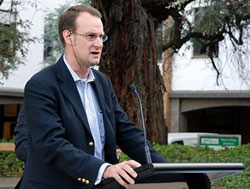


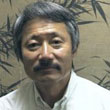



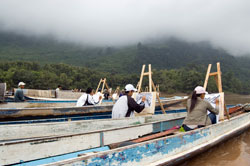
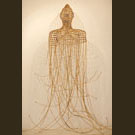
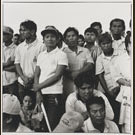

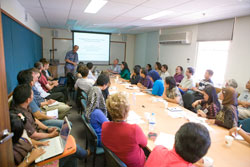

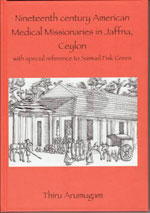
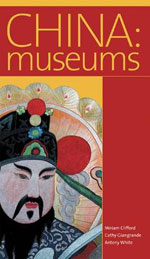
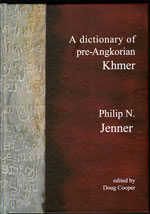

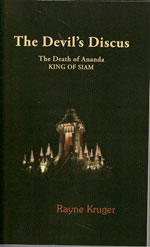 Rayne Kruger
Rayne Kruger
